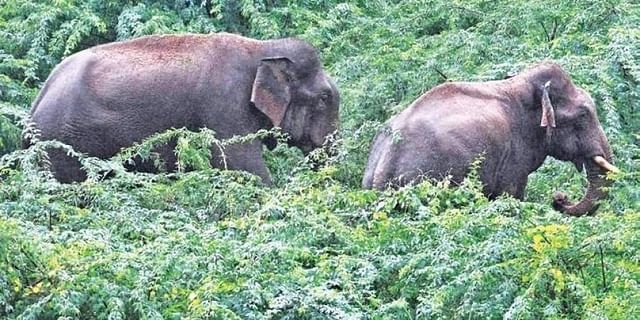TIRUNELVELI : With the incidents of elephant intrusion rising of late, animal lovers are urging authorities to restore the jumbos’ habitat and to identify a corridor.
Officials of Kalakkad Mundanthurai Tiger Reserve (KMTR) said that though the forest is home to no elephant, more than 250 elephants migrate to the forest from the Tiger reserve in Kerala every year.
“At present, elephants are found in the core area of the tiger reserve and their movements are recorded frequently. The movements are being recorded even in Mundanthurai plateau,” they said.
The findings of Synchronized Elephant Population Estimation, 2017, peg elephant number in KMTR at 58. Meanwhile, Status of Tigers Copredators and Prey in India 2018 have detected 13 herds in the reserve forest.
Experts said that the three major linear barriers in the corridor are National Highway 208, Punalur-Sengottai railway line and A 400 KV power line, which is on the Tamil Nadu-Kerala border.
Forest officials said that there is no defined path for the migratory elephants in the KMTR at present. “The intrusion is seen only in certain seasons. Plus, the elephants tend to intrude into human habitations when their corridor is interrupted with human activity. For example, Sabarimala Ayyappa temple in Kerala is located on an elephant corridor. During Sabarimala season when the temple and the surrounding areas are flooded with devotees, the elephants take a detour and enter into KMTR through the migratory path,” an expert said.
This apart, the mosquitoes also play a role in forcing elephants to venture out of the forest. “This mainly occurs after the end of monsoon. Meanwhile in summer, they mainly venture out of forest to eat fruits,” officials pointed out, adding that such intrusions, at times, may turn fatal for them.
A cow elephant was electrocuted when it came in contact with a fence in December 2020. This was the first such incident reported in KMTR.
Ask the residents of Pottal and other villages in Ambasamudram Taluk and they would say that they are witnessing regular movement of elephants in the area. A villager, Murugesh (47), said that for the past few years, he has been seeing the elephants passing through the farm lands, looking for coconuts. “Now, it is quite normal. Usually, we report such intrusions to the forest officials and seek their help to shoo them away,” he said.
In contrast, the Kaanis living in the tribal settlement of KMTR said that they never scare the elephants off and they let the animals eat the fruits growing in their backyard.
Senior Research Associate ATREE, Mathivanan, who has been monitoring the movement of the elephants said that in case the elephant corridor is being blocked due to developmental activities, an underpass could be constructed so that the elephants could pass through them without any disturbance. He also suggested restotaion of habitat for the elephants.

